.
If you have any comments, observations, or questions about what you read here, remember you can always Contact Me
All content included on this site such as text, graphics and images is protected by U.S and international copyright law.
The compilation of all content on this site is the exclusive property of the site copyright holder.
Where did it start? Well might you ask. Actually, it started many years ago. An inquisitive child, I always wanted to see things for myself. Have a cup of hot tea with lemon in it and decide to add some milk. "It will curdle!" exclaimed my grandmother / sister / mother / someone. So it does. I watched it do that.
Or I remember buying a small container of whipping cream and using one of those old fashioned hand egg beaters - are you old enough to remember them?
 Two intermeshing sets of beaters, a handle at the top, and a handle at the side that was turned to spin the beaters to mix eggs or whip cream. Turn, turn, turn. "Stop," said my grandmother, "or your whipped cream will turn to butter." That's what I wanted to watch.
Two intermeshing sets of beaters, a handle at the top, and a handle at the side that was turned to spin the beaters to mix eggs or whip cream. Turn, turn, turn. "Stop," said my grandmother, "or your whipped cream will turn to butter." That's what I wanted to watch.
So there were memories somewhere in the deeper recesses of my mind, stirred to life last March when Connie Unangst demonstrated making butter and also fresh acid set cheese from milk and vinegar at the Bouman Stickney Museum's butter making event.
In the throes of the powerful "I do it myself!" I decided to make some cheese myself. Now, fresh acid set cheese is a doodle: heat some milk, add lemon juice or vinegar or citric acid. Stir. Let sit. And hey presto - curds and whey, Little Miss Muffet. I chose citric acid as unlike lemon juice or vinegar it is neutral in flavor while they give the cheese a somewhat sour, acid tang.
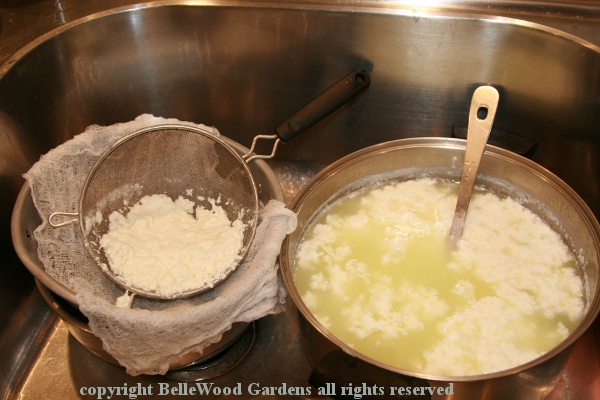
Proud of my accomplishment, I was telling someone about this at the April meeting of the Tohickon Garden Club. Which caught someone else's attention. And the next thing I knew there was sufficient interest to offer a Dairy 101 demonstration workshop as a non-monthly meeting event, similar to the backyard maple syrup event in 2014. In fact, there were so many people that wanted to learn more about dairy / butter / simple cheese making that we ended up with two sessions since I wanted to keep attendance to a modest number at each event.
What to include? Start with milk.
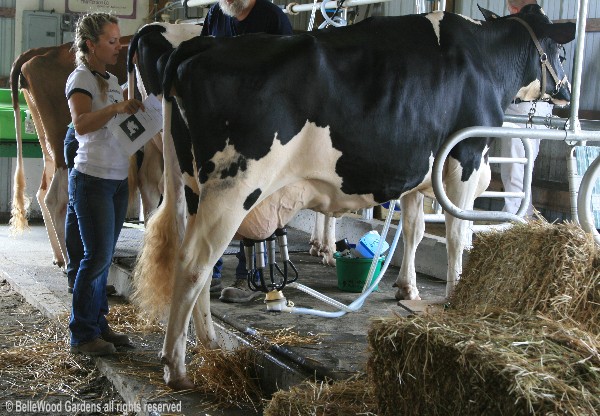
In general, commercial dairies focus on Holstein - Friesian cows, such as
this one at the 4-H fair. High yield, almost 9 gallons / day, lower butterfat.
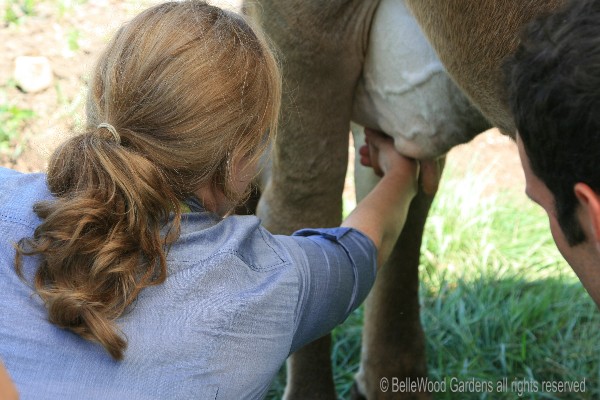
Jersey and Guernsey cows have lower yield of
richer, creamier milk, around 5 gallons per cow per day.

Dairy goats produce naturally homogenized milk. An Alpine,
like this one, produces 2 1/2 to 3 quarts / day at peak lactation
down to between 1 and 2 quarts later in the lactation cycle.
Schlepp two boxes of "stuff" into the fire station's social hall kitchen - collated and stapled handouts, large stainless steel pot, various strainers, perforated and solid spoons, ladle, various size measuring cups, instant read thermometer, napkins, small disposable cups, plastic spoons / knives / forks, crackers for sampling cheeses and butter, and other bits and bobs for embellishment such as strawberry coulis, sour cherry coulis, nutmegs and nutmeg grater, cinnamon, salt, sugar, citric acid. Big heavy Kitchenaid stand mixer. And a picnic cooler with assorted dairy.
Since as far as I know no one has a cow it would all begin with store-bought milk. First place, then, is how to read a label: what does homogenized, pasteurized, ultra-pasteurized mean and what does it mean for cheese making.
At home I had strained yogurt overnight so we had yogurt cheese and its whey to taste as a beginning. Everyone got to smear some on a cracker. Taste. New sample. Add a dab of strawberry or sour cherry coulis. Taste. Another sample. Add a pinch of nutmeg and cinnamon. Taste. We're off to a good start.

photo by Joan Carter, used with permission
The magic of ever-so-easy fresh acid-set cheese. Carefully heat the milk to somewhere around 170 to 185 degrees Fahrenheit. Carefully, so as not to scorch or boil. Add your chosen curddling agent. Stir. Let stand. Drain. Call it curd cheese, pot cheese, farmer's cheese, or quark. Drain it a little more thoroughly and it becomes paneer. It seems that every population with dairy animals has some version or another of this. Once the curds are well formed it is time to separate the curds and whey.
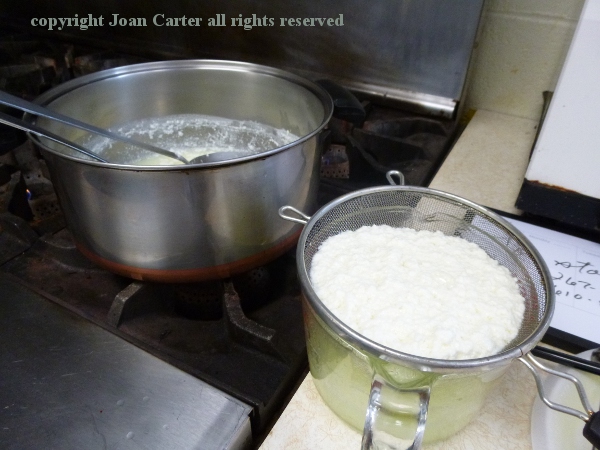
photo by Joan Carter, used with permission
Start with a fine mesh strainer, or line a coarse mesh strainer with butter muslin, unbleached muslin from the fabric store. Wash it first. It can be used again and again. Just rinse it in cold water after using, then wash thoroughly. Forget the gauzy "cheesecloth" from your local hardware store which is more like mosquito netting, thin and flimsy.

photo by Joan Carter, used with permission
A half-gallon of milk will yield about a pound of cheese and about a quart and a half of whey. What to do with whey? Drink it. Muddle sone fresh mint leaves and steep with whey. Blend equal parts whey and soft canteloupe for another delicious drink. Bake bread with it. Use whey as a base for vegetable soups. Do you lacto-ferment vegetables? If yes, try using whey instead of salt. Feed it to the pigs, chickens, dog. Spray whey on squash or cucumber plants that have powdery mildew.
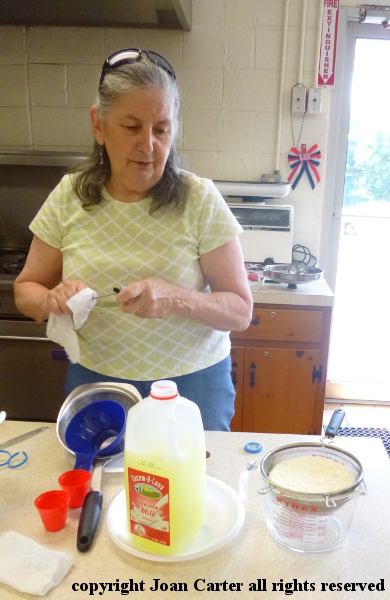
photo by Joan Carter, used with permission
Hmmm. What shall I do with you . . . .
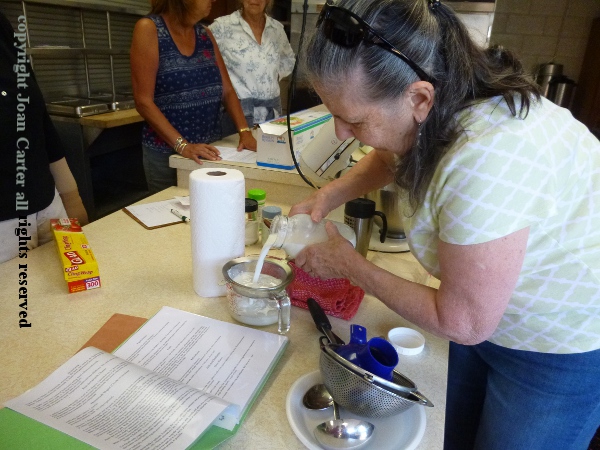
photo by Joan Carter, used with permission
Over the previous week I had been propagating keffir grains at a furious rate so as to have enough to share with those who might want to take some home and cultivate their own. Everyone, as it turned out. Keffir is a wonderful probiotic, even better than yogurt, with multiple strains of lactobacillus and also a few good yeast strains too. Strain out the grains to have a good, tangy, slightly tart beverage. Feed the grains with more milk. Set the jar on a counter at room temperature and in 12 to 24 hours (depending on how tart you like it) another batch of keffir is ready to drink. Refrigerate for slow production and of course, refrigerate after straining.

photo by Joan Carter, used with permission
The white lumpy bits in the spoon are keffir grains
(which do not have anything to do with cereal grains.)
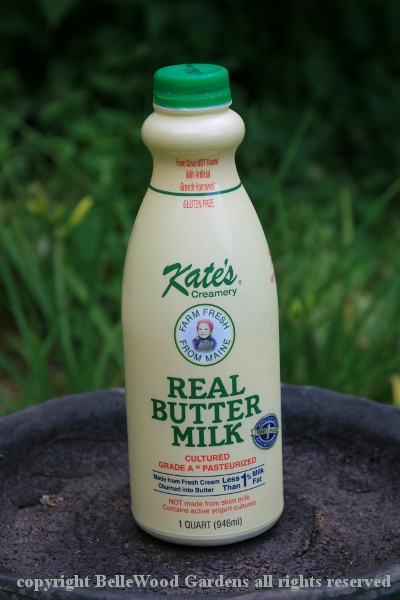
I explained about buttermilk that you buy at a store and the buttermilk which is something left after making butter. The first is a cultured product. You can make your own by adding some of the cultured buttermilk to fresh milk and letting it propagate. What might you do with cultured buttermilk? Tangy and lovely to drink. Buttermilk pancakes or biscuits. Buttermilk ranch salad dressing. Marinate chicken in buttermilk, then make fried chicken.
Milk must be heated to make fresh acid set cheese. Want to make yogurt? Same thing, milk must be warmed. Butter though, butter comes from heavy cream. And it must be cold. Older is also good, butter comes more readily from older cream than new. Use a butter churn, should you have one. Or a clean glass jar with a tight fitting lid and a few glass marble inside. Shake, shake, shake. Shake some more. Come butter come.
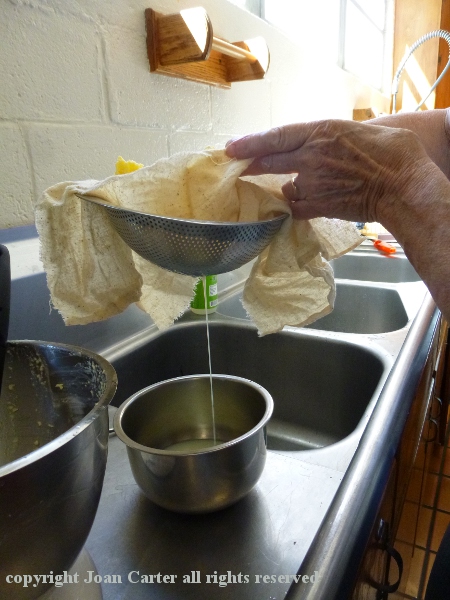
And the cream - it becomes butter. Drain off the sweet, creamy buttermilk.
Paddle the butter with ice cold water to pull out any remaining buttermilk.

Put it in the butter muslin and squeeze really hard. Beautiful sweet butter.
Now if you started with goat milk, naturally homogenized with small, evenly dispersed particles of fat you must first use a cream separator. And goat milk butter is white. I don't know about sheep milk (which makes fine cheese.) Or mare's milk, popular in France and Russia. Water buffalo milk mozzarella, Mozzarella di Bufala. Yak milk, super high in fat is used in Tibet to make yak butter. Served in tea it is a staple food. Everywhere around the world where people keep dairy animals they drink the milk, make cheese, make butter.
Dairy 101. It's fun. Delicious. Nutritious. And you can do it too.
Back to Top
Back to June 2016
Back to the main Diary Page